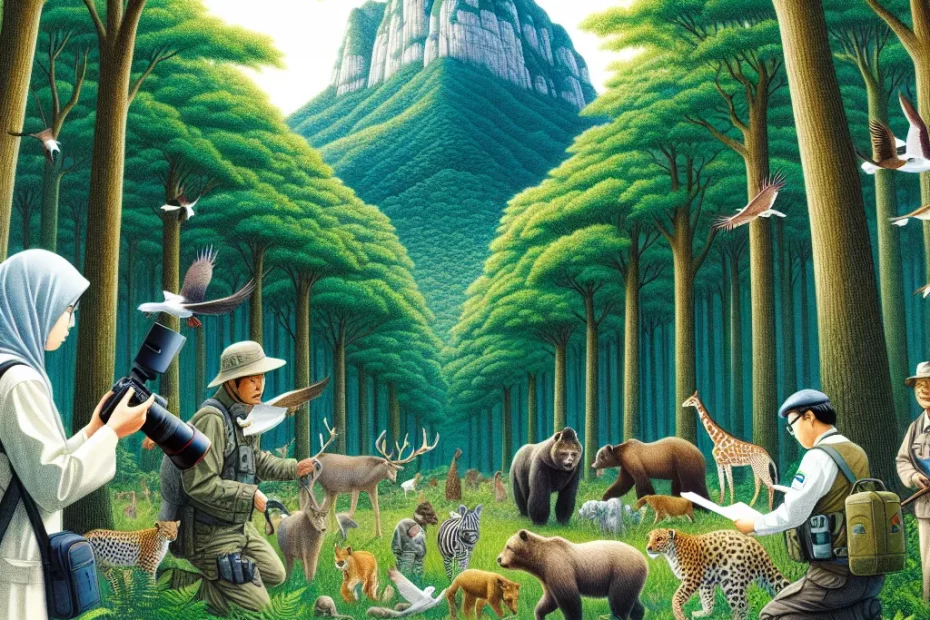In the heart of South Korea lies a treasure trove of natural wonders waiting to be explored and preserved. From lush forests to towering mountains, Korea’s national parks offer a glimpse into the country’s rich biodiversity. Conservation efforts in these protected areas are crucial for maintaining the delicate balance of ecosystems and safeguarding endangered species. Despite facing challenges, such as human encroachment and climate change, Korea has made significant strides in national park management. Let’s delve into the diverse landscapes and the ongoing conservation initiatives that make Korea’s national parks truly special.

Exploring Korea’s Diverse National Parks
Welcome to the breathtaking world of Korea’s National Parks, where nature’s wonders unfold in all their glory! 🌿 From lush forests to majestic mountains, Korea’s diverse national parks offer a sanctuary for both wildlife and outdoor enthusiasts alike. Let’s embark on a journey through these natural treasures and discover the beauty and conservation efforts that make them truly remarkable. 🏞️
Korea’s National Parks
In Korea, there are 22 national parks that cover approximately 3% of the country’s total land area. These parks are not only vital for preserving the country’s rich biodiversity but also serve as recreational spaces for visitors to enjoy. With over 1,400 plant species and 3,000 animal species, including endangered ones, these parks play a crucial role in conservation efforts. 🌺🦌
Seoraksan National Park
Seoraksan National Park, located in the northeastern part of Korea, is a prime example of the country’s natural splendor. With its rugged rock formations, dense forests, and rare flora and fauna, Seoraksan is a UNESCO Biosphere Reserve that attracts hikers and nature lovers from around the world. 🏔️🌸
Jirisan National Park
Jirisan National Park, the largest in Korea, is another gem waiting to be explored. Home to diverse ecosystems, including temperate forests and alpine meadows, Jirisan is a haven for wildlife such as Korean goral and black bears. The park’s pristine environment and well-preserved habitats make it a hotspot for ecotourism. 🐻🍃
Hallasan National Park
Not to be missed is Hallasan National Park, located on Jeju Island, a UNESCO World Heritage Site. Hallasan, a shield volcano, dominates the island’s landscape and offers a challenging yet rewarding hiking experience. The park is also home to unique species like the Jeju shelduck and the Jeju weasel, highlighting the importance of preserving these natural habitats. 🌋🦆
Conservation Efforts
As we delve deeper into Korea’s national parks, it becomes evident that conservation efforts are paramount to protecting these invaluable ecosystems. Through initiatives such as habitat restoration, wildlife monitoring, and community engagement, Korea is committed to ensuring the long-term sustainability of its national parks. 🌳🌍
So, whether you’re seeking adventure, tranquility, or a deeper appreciation for nature, Korea’s national parks have something for everyone. Join us in exploring these natural wonders and witness firsthand the beauty and importance of conservation in Korea’s diverse landscapes. Let’s cherish and protect these national treasures for generations to come! 🌏🌿
Preserving Biodiversity in Korean Ecosystems
In the rich tapestry of Korean ecosystems, the preservation of biodiversity stands as a paramount mission. With over 20 national parks spread across the country, Korea boasts a diverse range of habitats that are home to a myriad of plant and animal species. These national parks serve as sanctuaries for both common and endangered species, playing a crucial role in maintaining the delicate balance of the ecosystem.
The Role of National Parks
The Korean government has designated these national parks to protect and conserve the natural heritage of the country. Through rigorous monitoring and research, efforts are made to safeguard the unique flora and fauna that inhabit these pristine landscapes. The biodiversity within these parks is not only a source of wonder and beauty but also a vital component of the ecosystem’s resilience.
Seoraksan National Park
One such example is the Seoraksan National Park, located in the northeastern part of Korea. This park is renowned for its diverse range of plant species, including rare alpine flora that thrive in the harsh mountain environment. The park is also home to various animal species such as the Korean goral and musk deer, adding to its ecological significance.
Jirisan National Park
Another notable national park is Jirisan, the largest mountain in the southern region of Korea. Jirisan National Park is a haven for numerous plant and animal species, with its lush forests providing a habitat for species like the Korean black bear and the endangered Korean goral. The conservation efforts in Jirisan highlight the commitment to preserving the rich biodiversity of Korean ecosystems.
Importance of Biodiversity Conservation
As the global climate continues to change, the importance of preserving biodiversity in Korean ecosystems becomes even more critical. By protecting these natural habitats and the species within them, we not only ensure the survival of unique plants and animals but also maintain the ecological balance that sustains life on Earth.
In conclusion, the conservation of biodiversity in Korean national parks is a noble endeavor that requires dedication and unwavering commitment. Through sustainable practices and active conservation efforts, we can secure a future where the rich tapestry of Korean ecosystems thrives for generations to come. Let us cherish and protect these natural treasures, for they are not just a part of our heritage but a legacy for the planet as a whole.
Conservation Efforts in Korea’s Protected Areas
In Korea, the national parks play a crucial role in preserving the country’s natural heritage and biodiversity. With a total of 22 national parks covering approximately 5.7% of the country’s land area, Korea has made significant efforts to protect and conserve these valuable ecosystems. 🌿
Enforcement of Regulations
One of the key strategies in the conservation of Korea’s protected areas is the strict enforcement of regulations to prevent illegal activities such as poaching, logging, and habitat destruction. The Korea National Park Service (KNPS) has been actively patrolling the parks to ensure compliance with these regulations, resulting in a noticeable decrease in illegal activities over the years. 🚓
Habitat Restoration and Reforestation
Furthermore, Korea has been focusing on habitat restoration and reforestation projects within the national parks. By replanting native tree species and restoring degraded habitats, the country aims to enhance biodiversity and create a more resilient ecosystem. 🌳
Research and Monitoring Programs
In addition to on-the-ground conservation efforts, Korea has been actively engaging in research and monitoring programs to better understand the ecological dynamics of its national parks. Through the use of advanced technologies such as camera traps and satellite imagery, researchers have been able to gather valuable data on wildlife populations, habitat usage, and environmental changes. 📊
Community Involvement and Education
Moreover, community involvement and education play a vital role in the success of conservation efforts in Korea’s protected areas. The KNPS has been working closely with local communities to raise awareness about the importance of conservation and to promote sustainable practices. By involving the public in conservation initiatives, Korea is fostering a sense of stewardship and responsibility towards the natural environment. 🌏
Overall, Korea’s national parks serve as invaluable sanctuaries for a wide range of plant and animal species, some of which are endangered or endemic to the region. Through dedicated conservation efforts, Korea is not only preserving its natural heritage but also setting an example for sustainable environmental management on a global scale. 🌍
As we continue to face environmental challenges, the conservation efforts in Korea’s protected areas serve as a beacon of hope and inspiration for the future of our planet. Let us all work together to protect and cherish these precious natural treasures for generations to come! 🌟
Challenges and Successes in National Park Management
Challenges:
1. Overcrowding: One of the biggest challenges facing national parks is the issue of overcrowding. As the popularity of these parks continues to grow, the increased foot traffic can lead to environmental degradation, wildlife disturbance, and safety concerns for both visitors and wildlife.
2. Funding: Securing adequate funding for the maintenance and conservation of national parks is a constant struggle. Limited budgets can hinder essential infrastructure upgrades, wildlife protection efforts, and visitor education programs.
3. Climate Change: The impacts of climate change pose a significant threat to national parks. Rising temperatures, changing precipitation patterns, and extreme weather events can disrupt ecosystems, alter wildlife behavior, and increase the risk of natural disasters like wildfires.
4. Invasive Species: The introduction of invasive species can have devastating effects on native flora and fauna within national parks. Controlling and eradicating these species requires significant resources and ongoing monitoring efforts.
Successes:
1. Conservation Efforts: National parks have been successful in implementing conservation initiatives to protect endangered species, restore habitats, and preserve biodiversity. These efforts have helped to revitalize ecosystems and ensure the long-term sustainability of park resources.
2. Community Engagement: Engaging local communities and stakeholders in park management decisions has been key to the success of many national parks. Collaborative partnerships foster a sense of ownership and stewardship among residents, leading to more sustainable conservation practices.
3. Technology Integration: The use of technology, such as remote sensing, GPS tracking, and data analytics, has revolutionized national park management. These tools enable park officials to monitor wildlife populations, track visitor patterns, and make informed decisions to enhance conservation efforts.
4. Education and Outreach: National parks have made significant strides in educating visitors about environmental conservation, wildlife protection, and sustainable tourism practices. Interpretive programs, guided tours, and interactive exhibits help raise awareness and promote responsible behavior among park visitors.
In conclusion, while national park management presents various challenges, the successes achieved through conservation efforts, community engagement, technological advancements, and education initiatives demonstrate the importance of prioritizing the protection and preservation of these natural treasures. By addressing these challenges and building upon these successes, we can ensure the long-term sustainability and enjoyment of national parks for generations to come.
Korea’s national parks are not just natural treasures, but also vital ecosystems that require careful preservation. Through ongoing conservation efforts, these protected areas serve as havens for diverse flora and fauna, ensuring the continued existence of unique species. Challenges in park management exist, but successes in maintaining biodiversity showcase the dedication and expertise of those involved. As we explore and appreciate the beauty of Korea’s national parks, let us also recognize the importance of our role in their conservation. Let us strive to be responsible stewards of these invaluable natural resources for future generations to enjoy.
